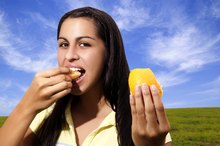How Does Teen Nutrition Affect Growth, Development & Learning?
Healthy eating and proper nutrition are important at all life stages and are especially vital during adolescence. That's when young people need the most calories and are rapidly growing and developing. Eating poorly as a teen has both short- and long-term negative consequences that can range from a bad test grade to a higher risk of serious chronic diseases.
Nutrient Roles
Carbs, proteins and fats all play important roles in a teen’s diet. Carbs are a teen’s main energy source and an aid to keeping blood sugar levels under control, which can prevent sudden energy crashes and may even improve focus. Proteins contribute to healthy organ and muscle growth and development and are overabundant in most teens’ diets. Healthy dietary fats promote proper skin and hair development and help teens absorb other essential vitamins and minerals. Micronutrients, including calcium and iron, are also critical for teens. Specifically, a research review published in 2005 in the "Journal of School Health" concluded that iron-deficient students were at an academic disadvantage but improved cognitively after undergoing iron therapy.
- Carbs, proteins and fats all play important roles in a teen’s diet.
- Proteins contribute to healthy organ and muscle growth and development and are overabundant in most teens’ diets.
Overnutrition Risks
Healthy Diet for a Teenage Boy
Learn More
Teens need a lot of calories throughout early adolescence -- about 2,800 daily for boys and about 2,200 daily for girls. However, if they’re eating a lot of junk food or just overeating in general, overnutrition and weight gain can become a problem. Excess weight gained during adolescence doesn’t often go away automatically, even after growth spurts. According to the American Academy of Child & Adolescent Psychiatry, an obese adolescent has an 80 percent chance of becoming an obese adult, which raises long-term risks of heart disease, diabetes and sleep problems. Teens who are obese also tend to have lower self-esteem and greater emotional difficulties.
- Teens need a lot of calories throughout early adolescence -- about 2,800 daily for boys and about 2,200 daily for girls.
- According to the American Academy of Child & Adolescent Psychiatry, an obese adolescent has an 80 percent chance of becoming an obese adult, which raises long-term risks of heart disease, diabetes and sleep problems.
Bone Growth
One of the most important nutrients for teens is calcium, but two-thirds of American adolescent girls don’t meet daily requirements for the mineral. According to the American Academy of Pediatrics, your bones begin to stop taking in calcium deposits by the time you reach early adulthood, which is why it’s critical to get enough calcium as a teen. Teens who don’t meet calcium requirements have higher risks for brittle bones, bone breakage, stunted bone growth and osteoporosis later in life.
Academic Performance
Nutrition for Teen Girls
Learn More
Teens with poor eating habits are at risk academically as well as physically. An unhealthy diet doesn't meet daily recommendations for fruit and vegetable intakes and consists of mainly processed foods, refined grains and foods that are high in fat, sugar, cholesterol, sodium or all four. According to the Centers for Disease Control and Prevention, students who practice unhealthy eating are more likely to receive poor grades, get low test scores and pursue less education. Relatedly, teens who do not get enough food and are often hungry are more likely to miss school or repeat a grade, according to the National Education Association.
- Teens with poor eating habits are at risk academically as well as physically.
- According to the Centers for Disease Control and Prevention, students who practice unhealthy eating are more likely to receive poor grades, get low test scores and pursue less education.
Related Articles
References
- HealthyChildren.org: Calcium -- The Teen Bone Builder
- Center for Young Women's Health: Calcium and Teens
- HealthyChildren.org: A Teenager's Nutritional Needs
- Centers for Disease Control and Prevention: Health and Academics
- National Education Association: Facts About Child Nutrition
- MedlinePlus: Dietary Fats Explained
- Journal of School Health: Nutrition and Student Performance at School
- Data and Statistics on Children's Mental Health. Centers for Disease Control and Prevention. Reviewed April 19, 2019.
- Das JK, Salam RA, Lassi ZS, et al. Interventions for Adolescent Mental Health: An Overview of Systematic Reviews. J Adolesc Health. 2016;59(4S):S49-S60. doi:10.1016/j.jadohealth.2016.06.020
Writer Bio
Carly Schuna is a Wisconsin-based professional writer, editor and copy editor/proofreader. She has worked with hundreds of pieces of fiction, nonfiction, children's literature, feature stories and corporate content. Her expertise on food, cooking, nutrition and fitness information comes from a Level 1 personal training certification and years of in-depth study.









